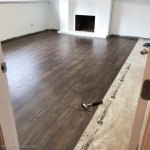How Much Does It Cost to Install Tile on a Bathroom Floor?
Installing tile on a bathroom floor is a popular home improvement project that can significantly enhance the aesthetic appeal and functionality of a space. Tile offers durability, water resistance, and a wide range of design options. However, understanding the costs associated with professional tile installation is crucial for budgeting and planning purposes. The total cost can vary substantially depending on several factors, making it essential to conduct thorough research and obtain accurate estimates.
This article will delve into the various elements that influence the overall expense of bathroom tile floor installation, providing a comprehensive overview of pricing considerations. It will explore the costs of materials, labor, and potential preparatory work, as well as factors that might increase or decrease the final investment. Understanding these aspects will empower homeowners to make informed decisions and effectively manage their tile installation projects.
Key Considerations Affecting Tile Installation Costs
Several key factors play a significant role in determining the final cost of installing tile on a bathroom floor. These factors encompass the type of tile selected, the size and complexity of the bathroom, the existing floor conditions, and the prevailing labor rates in the homeowner's geographical location. Careful consideration of each element is vital for accurate cost estimation.
The type of tile chosen significantly impacts the overall cost. Ceramic and porcelain tiles are generally more affordable than natural stone options like marble or granite. Furthermore, the size and shape of the tile influence both material and labor costs. Larger tiles may require less labor to install, while intricate mosaic patterns or unconventional shapes can increase labor time and complexity. The condition of the subfloor is also a critical factor. If the subfloor is uneven, damaged, or requires extensive preparation, the cost of the project will inevitably increase due to the added labor and materials necessary to create a stable and level surface for the tile.
Geographical location exerts a considerable influence on labor rates. Labor costs tend to be higher in metropolitan areas and regions with a high cost of living. Obtaining quotes from multiple qualified contractors in the specific area is essential for gauging fair market prices and avoiding overpayment. It is also prudent to inquire about potential additional costs, such as disposal fees for old flooring, sealant application, or grout upgrades. A comprehensive understanding of these cost drivers facilitates effective budgeting and prevents unexpected expenses during the installation process.
Breaking Down Material Costs
The cost of materials constitutes a significant portion of the overall tile installation budget. This includes not only the tile itself but also essential supplies such as thin-set mortar, grout, sealant, and potentially backer board or self-leveling compound for subfloor preparation. The selection of these materials should be based on factors such as tile type, bathroom size, and desired aesthetic.
Tile prices vary considerably based on material, quality, and design. Ceramic and porcelain tiles are generally the most budget-friendly options, ranging from approximately $1 to $15 per square foot. Natural stone tiles, such as marble, granite, and slate, are typically more expensive, with prices ranging from $5 to $50 per square foot or even higher, depending on the rarity and grade of the stone. Glass tiles offer a modern aesthetic but can also be relatively costly, ranging from $8 to $30 per square foot.
Beyond the tile itself, the cost of mortar, grout, and sealant must be factored in. Thin-set mortar, which is used to adhere the tile to the subfloor, typically costs between $15 and $40 per bag, depending on the type and brand. Grout, used to fill the spaces between tiles, ranges from $15 to $60 per container, again varying based on type, color, and brand. Sealant, which protects the grout and tile from moisture and stains, can cost between $10 and $30 per bottle. If the subfloor requires preparation, materials such as backer board (approximately $10 to $20 per sheet) or self-leveling compound (ranging from $30 to $60 per bag) may be necessary, adding to the overall material expenses. Accurately estimating the quantity of each material needed is crucial to avoid shortages or unnecessary surplus.
Understanding Labor Costs and Project Scope
Labor costs represent a substantial portion of the overall expense of bathroom tile floor installation. These costs are influenced by factors such as the complexity of the job, the size of the bathroom, and the prevailing labor rates in the area. Obtaining detailed quotes from multiple qualified contractors is essential for understanding the scope of work and the associated labor charges.
Professional tile installers typically charge either by the square foot or by the hour. Square footage rates can range from $4 to $15 per square foot or more, depending on the tile type, pattern complexity, and the need for specialized installation techniques. Hourly rates typically range from $50 to $150 per hour. More intricate designs, such as mosaic patterns or custom inlays, will command higher labor rates due to the increased time and skill required for installation. Additionally, if the existing flooring needs to be removed or the subfloor requires extensive preparation, such as leveling or reinforcement, this will significantly increase the labor hours and overall project cost. Contractors must assess the existing conditions and provide a comprehensive quote outlining all labor-related expenses.
The project scope encompasses not only the tile installation itself but also any necessary preparatory work, such as demolition of existing flooring, subfloor repair or leveling, and post-installation cleanup. A detailed contract should clearly outline all aspects of the work to be performed, including the responsibilities of the contractor and the homeowner. It is essential to verify that the contractor is licensed, insured, and possesses the necessary experience to complete the project to a high standard. Furthermore, clear communication regarding the project timeline, payment schedule, and any potential change orders is crucial for a smooth and successful tile installation process.
Factors That Can Increase Installation Costs
Several factors can contribute to an increase in the initial estimated cost of bathroom tile floor installation. These factors range from unforeseen issues discovered during demolition to changes in the scope of the project or upgrades to materials. Being aware of these potential cost-increasing elements is crucial for managing expectations and avoiding budget overruns.
One common cause of increased costs is the discovery of unforeseen problems with the subfloor during the demolition process. If the subfloor is found to be damaged, uneven, or structurally unsound, additional repairs or reinforcement will be necessary before tile installation can proceed. This can involve patching cracks, leveling uneven surfaces, or even replacing sections of the subfloor altogether. The cost of these repairs can vary significantly depending on the extent of the damage and the materials required.
Another factor that can increase costs is changing the scope of the project mid-installation. For example, if the homeowner decides to upgrade to a more expensive tile, add a decorative border, or change the tile pattern, this will likely result in additional labor and material costs. It’s important to carefully consider design choices and finalize them before the installation begins to minimize the risk of change orders. Hidden plumbing or electrical issues can also contribute to increased costs. If pipes or wiring need to be rerouted or repaired to accommodate the new tile layout, this will add to the overall project expense.
In addition to these factors, upgrades to materials, such as choosing a higher-quality grout or sealant, can also increase the cost. While these upgrades may provide better performance or longevity, they will come at a higher price. Open communication with the contractor throughout the project is essential for addressing any unforeseen issues or changes in scope promptly and transparently. Obtaining written estimates for any additional work or materials is crucial for maintaining control over the budget and avoiding unexpected expenses.
Strategies for Reducing Tile Installation Costs
While installing tile on a bathroom floor can be a significant investment, there are several strategies homeowners can employ to reduce the overall cost. These strategies range from selecting more budget-friendly materials to performing some of the preliminary work themselves.
Choosing less expensive tile options is one of the most straightforward ways to reduce costs. Ceramic and porcelain tiles are generally more affordable than natural stone or glass tiles, and they offer a wide range of styles and designs to suit various aesthetic preferences. Opting for simpler tile patterns can also help minimize labor costs, as intricate designs require more time and skill to install.
Another way to save money is to perform some of the preparatory work yourself, such as removing the old flooring, cleaning the subfloor, and painting the walls. However, it's important to be realistic about your skills and abilities and to only undertake tasks that you are comfortable and competent in performing. Improperly performed preparatory work can actually increase the overall cost of the project if it needs to be corrected by the professional installer.
Obtaining multiple quotes from different contractors is crucial for ensuring that you are getting a fair price for the installation work. Be sure to compare the quotes carefully, paying attention to the scope of work included, the materials specified, and the payment schedule. It's also important to check the contractor's credentials and references to ensure that they are qualified and experienced. Consider purchasing the tile and materials yourself, as this can sometimes result in cost savings, especially if you can find a good deal online or at a local tile store. However, it's important to coordinate with the contractor to ensure that you are purchasing the correct type and quantity of materials. By carefully considering these strategies, homeowners can effectively manage their tile installation budget and achieve their desired bathroom renovation goals.

Tile Flooring Installation Cost Floor S Fixr

How Much For A New Bathroom Tile Floor

Cost To Tile A Bathroom Floor Average Install Tiles

How Much Does Tiling A Bathroom Cost 2025

What S The Cost To Install Bathroom Floor Tiles In Tucson

How Much Does Tiling A Bathroom Cost 2025

What S The Cost To Install Bathroom Floor Tiles In Tucson

Cost To Install Tile The Home

What Is The Average Cost To Install Tile Floors Rubi Blog Usa

How To Lay Tile Install A Ceramic Floor In The Bathroom Diy
See Also







